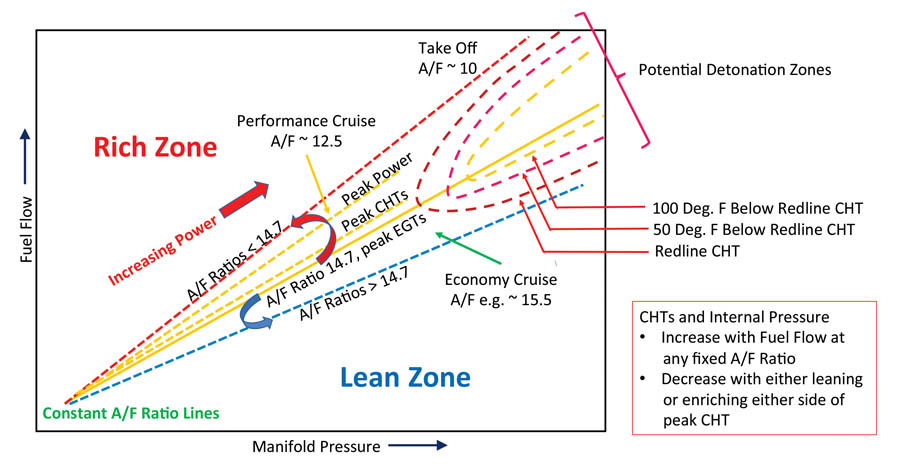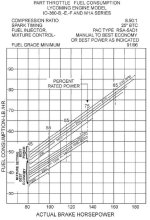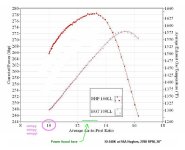Van's Air Force
You are using an out of date browser. It may not display this or other websites correctly.
You should upgrade or use an alternative browser.
You should upgrade or use an alternative browser.
Factory Lycoming IO-360 AFR
- Thread starter jclemens
- Start date
BoydBirchler
Well Known Member
There are a few threads here on VAF that touch on "air fuel ratio's". There are many variants of the Lycoming IO-360: parallel valve, angle valve with compression ratio's as low as 7:1 and as high as 10:1 (and even higher CR ratio's for after market pistons and different flows with after market cam shafts)). I'm confident the AFR is affected by any and all of these differences.
Anyone know what a stock IO-360 Lyc AFR is at WOT?
Whatever the pilot sets with the mixture control.
All valid points. Most io-360's are 8.7-1 or 8.5-1 compression ratio. I don't know that the AFR would be directly affected by c/r, it may require more or less fuel to get to the same AFR however. Also when at WOT most pilots set the mixture control to full rich. So I guess my real question is does anyone know what the average AFR on a typical stock IO-360 with the mixture full rich? Or more to the point, what did lycoming intend it to be at takeoff? I am aware that they probably didn't base the amount of full power takeoff fuel flow on AFR, I just wanted to know if anyone ever measured it to see.
Ralph Inkster
Well Known Member
Lycoming Operators Manual has multiple performance charts in Section 3 depicting minimum allowable fuel flow, suggested high limit, lean limit, etc.
I couldn't see one specifically for the IO but flow rates/mixture ratios should be similar regardless of model.
Refer to figures 3-16,3-50 as a relative example, you could set your mixture to these flow rates & read what resulting AFR (I think you have a Ballenger AFR gauge?) & see what you come up with.
As an aside, I have found my engine bogs down anything richer than 9:1, peak power is around 12.5 to 13.5, I set my best power around 11.5:1, my personal LOP is set around 16.5:1.
I couldn't see one specifically for the IO but flow rates/mixture ratios should be similar regardless of model.
Refer to figures 3-16,3-50 as a relative example, you could set your mixture to these flow rates & read what resulting AFR (I think you have a Ballenger AFR gauge?) & see what you come up with.
As an aside, I have found my engine bogs down anything richer than 9:1, peak power is around 12.5 to 13.5, I set my best power around 11.5:1, my personal LOP is set around 16.5:1.
Last edited:
Ralph Inkster
Well Known Member
Those charts are pretty vague. Maybe, based on max HP at what ever altitude you test at & those vague charts you can figure the sweet spot value.
Note also that factory flow values will reflect some portion for cooling...
Note also that factory flow values will reflect some portion for cooling...
Last edited:
I pretty much got the tuning where I want it on this build. I just wanted to compare my takeoff AFR with a stock factory engine. I am at about 10-1 at 2700, battling high oil temps. That's 17 GPH at 2700 rpm. Runs good, just wondered how rich a stock one is. Mines 10-1 c/r, hot cam, cold air, etc.
I should be around 210-215 HP and my compression ratio is 10:1, if you look at that same chart for a HIO-360, which is a 10:1 200 HP helicopter engine, it show a rich and lean range between 19.5 gph and 16.5. At 17 gph my AFR is reading 10-1, which is pretty rich but seems to run just fine. I had it set at 15.5 gph, which gave me a AFR of 11-1. CHT's were ok, approaching 400 climbing to 3K from sea level. 17 gph is 50 degrees cooler, which is great.
I should be around 210-215 HP and my compression ratio is 10:1, if you look at that same chart for a HIO-360, which is a 10:1 200 HP helicopter engine, it show a rich and lean range between 19.5 gph and 16.5. At 17 gph my AFR is reading 10-1, which is pretty rich but seems to run just fine. I had it set at 15.5 gph, which gave me a AFR of 11-1. CHT's were ok, approaching 400 climbing to 3K from sea level. 17 gph is 50 degrees cooler, which is great.
best power in most 4 cycle engines is around 12.5-13:1. Richer is sometimes required to assist with detonation in some cases. 10:1 is way too rich for most any engine IMHO, even those with high boost levels and you are losing power compared to best power levels. Better ways to cool the heads than throwing fuel at it.
FYI, higher compression ratios do not require richer AFR's to perform. However, higher CRs increase detonation potential and therefore require one to run on the richer side of the range to avoid it when conditions are ripe for it to occur.
Larry
Last edited:
Yeah I get all that. At 2500 RPM I am running at 12.5:1. Just running fatter at takeoff rpm. I am not concerned with my CHT's, it's my oil temp I am battling. I have a 13 row cooler mounted on the firewall and I am usually seeing 215-220 at TOC. I have a SJ cowl with a plenum and a 4" duct off the left rear cylinder baffle feeding the cooler. In climb there is not a lot of airflow unfortunately. As soon as you level off and speed up the oil temp comes right down. When I had takeoff set to 11:1 My CHT's were acceptable but the oil temp would hit 220-225 and I would level off to allow it to cool down. 10:1 gives me nice cool CHT's and about 10 degrees cooler oil so that's where I left it now. Just wandered how rich a factory engine is for cooling at takeoff. I guess I will have to order another Ballenger unit and slap it on a C172 or something. After filing all the appropriate paperwork and receiving proper approval from the FAA......
Yeah I get all that. At 2500 RPM I am running at 12.5:1. Just running fatter at takeoff rpm. I am not concerned with my CHT's, it's my oil temp I am battling. I have a 13 row cooler mounted on the firewall and I am usually seeing 215-220 at TOC. I have a SJ cowl with a plenum and a 4" duct off the left rear cylinder baffle feeding the cooler. In climb there is not a lot of airflow unfortunately. As soon as you level off and speed up the oil temp comes right down. When I had takeoff set to 11:1 My CHT's were acceptable but the oil temp would hit 220-225 and I would level off to allow it to cool down. 10:1 gives me nice cool CHT's and about 10 degrees cooler oil so that's where I left it now.
Respectfully, this an EAB classic. Builder wants speed and power, so he selects an inlet with poor pressure recovery at high AOA, and throws in high CR. However, when he tries to run it at best power, it has to be step climbed. So, to cool it he runs runs it rich as six feet up a cow's butt...a power reduction.
Folks, it's a system. We fuel to make power. We cool with air.
Just wandered how rich a factory engine is for cooling at takeoff.
An airframer might specify excess fuel flow because the cowl and baffling is poor, but the Lycoming's "minimum fuel flow for rated power" charts are clear...roughly 0.48~0.52 BSFC. Simply divide estimated horsepower (at the altitude of interest) by 2 for a reasonable estimate of fuel flow in lbs per hour at 0.5 BSFC In the field, full rich at 0.55 BSFC is plenty.
I guess I will have to order another Ballenger unit and slap it on a C172 or something. After filing all the appropriate paperwork and receiving proper approval from the FAA......
Or just use EGT. Best power is about 100 ROP, example below.
I've also attached a data table taken with all temperatures at maximum. Note BSFC's at max power and detonation onset. This kind of data determines the "minimum fuel flow for rated power" values.
.
Attachments
Yeah I get all that. At 2500 RPM I am running at 12.5:1. Just running fatter at takeoff rpm. I am not concerned with my CHT's, it's my oil temp I am battling. I have a 13 row cooler mounted on the firewall and I am usually seeing 215-220 at TOC. .
Nothing wrong with 220* OT for a couple of minutes. Modern oil doesn't start to seriously break down or oxidize until 250-260* Yes, running at 220 will produce a slightly shorter life span than 200, but we change the oil so often due to deposits that this irrelevant for us.
Larry
Last edited:
I am working on cooling it wit hair to get the Oil temps down so I can run closer to best power in climb as well as in cruise. But you are right, I did choose a cowl design that doesn't cool well and built an engine that makes too much heat when fueled properly. And it's not that fast, honestly I think I'm missing about 20 knots somewhere. Using .5 BSFC 17 GPH puts me right about the HP I should be making. I need to check the wideband calibration, 17 should not be that rich. I guess I can cross check it against the EGT next flight too. According to your chart 100 ROP should be around 12.5:1 AFR.
Using .5 BSFC 17 GPH puts me right about the HP I should be making.
Don't forget about the effect of altitude and temperature. Reputable engine vendors report corrected HP...the theoretical power it would make given sea level, standard day conditions. For example, if your engine pulled 200 corrected HP on a calibrated dyno, actual HP is roughly 183 at 75F and 2000 ft. A nice safe BFSC of 0.55 would be 15.25 GPH, and that drops continually in climb.
I need to check the wideband calibration, 17 should not be that rich. I guess I can cross check it against the EGT next flight too.
Jake, I realize some owners like A/F meters. However, I have doubts regarding accuracy, in particular long term accuracy given lead poisoning is guaranteed eventually. EGT is reliable.
Might want to pass on the proposed 17 gph cross check. Leaning to peak at full throttle with 10:1 CR has risk. Do it at 75% or less, after CHT has settled down in cruise.
yes, Density altitude on the last flight was 835 feet. That would make takeoff fuel flow a tad bit higher than full rated HP. However the plot thickens. I came across this chart from kitplane magazine suggesting that takeoff AFR is/should be/might be/? 10:1.

I wasn't proposing to cross check the AFR with EGT and takeoff power, I am aware that would be a poor decision. AFR should always be around Stoich at peak EGT regardless of what the power setting is. I will do that at 6-7K feet. I don't necessarily like A/F meters, One was supplied with my SDS kit and I installed it. It proved to be very short lived, went through sensors sometimes in single flights. I gave up on it for a while since the engine was running relatively well, then installed the Ballenger unit. It has been going strong since installation. It uses a different (more expensive) sensor. When the original sensors failed, it was evident, they weren't just wrong they were inop. Perhaps this one drifts. I think it has a free air self calibrate, I will read up on that.

I wasn't proposing to cross check the AFR with EGT and takeoff power, I am aware that would be a poor decision. AFR should always be around Stoich at peak EGT regardless of what the power setting is. I will do that at 6-7K feet. I don't necessarily like A/F meters, One was supplied with my SDS kit and I installed it. It proved to be very short lived, went through sensors sometimes in single flights. I gave up on it for a while since the engine was running relatively well, then installed the Ballenger unit. It has been going strong since installation. It uses a different (more expensive) sensor. When the original sensors failed, it was evident, they weren't just wrong they were inop. Perhaps this one drifts. I think it has a free air self calibrate, I will read up on that.
I came across this chart from kitplane magazine suggesting that takeoff AFR is/should be/might be/? 10:1.
Perhaps you should ask for the source of the figure.
BillL
Well Known Member
Yeah I get all that. At 2500 RPM I am running at 12.5:1. Just running fatter at takeoff rpm. I am not concerned with my CHT's, it's my oil temp I am battling. I have a 13 row cooler mounted on the firewall and I am usually seeing 215-220 at TOC. I have a SJ cowl with a plenum and a 4" duct off the left rear cylinder baffle feeding the cooler. In climb there is not a lot of airflow unfortunately. As soon as you level off and speed up the oil temp comes right down. When I had takeoff set to 11:1 My CHT's were acceptable but the oil temp would hit 220-225 and I would level off to allow it to cool down. 10:1 gives me nice cool CHT's and about 10 degrees cooler oil so that's where I left it now. Just wandered how rich a factory engine is for cooling at takeoff. I guess I will have to order another Ballenger unit and slap it on a C172 or something. After filing all the appropriate paperwork and receiving proper approval from the FAA......
It is a system for cooling and parallel flow for CHT and OT. If OT is too high and CHT too low, then you have too much air over the barrel/head fins. Go slowly as you can block 100% over the barrels and not change CHT - - it would cook the pistons.
Kitplanes editor says the AFR diagram was from George Braly (GAMI), so it is from the right people.
Yes, it's obviously a re-drawn "Red Box".
I did some checking, and 10 F/A is about right for full rich. I can even find some turbocharged stuff closer to 9. However, they won't make rated power at that figure.







